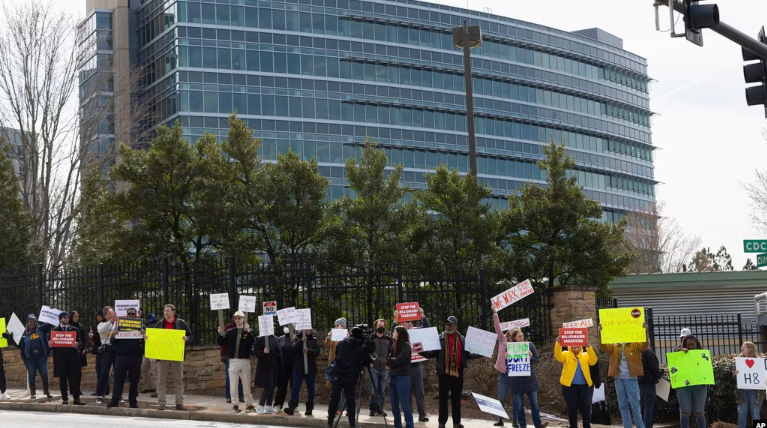(AP) – A federal judge in San Francisco ruled on Thursday, February 27, 2025, that the mass termination of probationary federal employees was likely unlawful, granting temporary relief to a coalition of labor unions and organizations challenging the Trump administration’s large-scale reduction of the federal workforce.
U.S. District Judge William Alsup ordered the Office of Personnel Management (OPM) to inform specific federal agencies that it lacked the authority to mandate the dismissal of probationary employees, including those at the Department of Defense.
“OPM does not have any authority whatsoever, under any statute in the history of the universe, to hire or fire any employees but its own,” Alsup stated in his ruling.
The lawsuit, filed by five labor unions and five nonprofit organizations, is one of several legal actions contesting the administration’s efforts to downsize the federal workforce—an effort that former President Trump has characterized as necessary due to government inefficiency.
While thousands of probationary employees have already been dismissed, the administration has now turned its focus toward career officials with civil service protections.
Government’s Defense and Courtroom Debate
Government attorneys acknowledged that OPM does not have the authority to directly hire or fire employees in other agencies. However, they argued that OPM had merely advised agencies to review probationary employees and determine their suitability for continued employment.
“I think plaintiffs are conflating a request by OPM with an order by OPM,” said Kelsey Helland, an assistant U.S. attorney, during Thursday’s proceedings.
They further contended that probationary employees are not guaranteed permanent employment and that only the highest-performing, mission-critical personnel should be retained.
Despite the ruling, the decision does not automatically reinstate terminated employees or prevent future dismissals. However, it sends a clear signal regarding the legality of the firings.
“What it means in practical effects is that the agencies of the federal government should hear the court’s warning that that order was unlawful,” said Danielle Leonard, an attorney representing the coalition.
Everett Kelley, national president of the American Federation of Government Employees, hailed the ruling as a crucial first step in protecting federal workers.
“This ruling by Judge Alsup is an important initial victory for patriotic Americans across this country who were illegally fired from their jobs by an agency that had no authority to do so,” Kelley said. “These are rank-and-file workers who joined the federal government to make a difference in their communities, only to be suddenly terminated due to this administration’s disdain for federal employees and desire to privatize their work.”
Requests for comment from OPM and the U.S. Department of Justice were not immediately returned.
Impact of the Ruling and Further Investigations
Judge Alsup ordered OPM to notify a limited number of federal agencies represented by the five nonprofit plaintiffs, which include organizations focused on veterans’ services, national parks, small businesses, and defense. He expressed particular concern over the dismissals at the Department of Defense.
Additionally, Alsup directed Charles Ezell, the acting head of OPM, to testify in court regarding a February 13 phone call in which agency leaders were instructed to fire probationary employees.
“The agencies could thumb their noses at OPM if they wanted to if it’s guidance, but if it’s an order, or cast as an order, the agencies may think they have to comply,” Alsup stated.
Probationary Employees’ Experiences and Ongoing Resistance
There are approximately 200,000 probationary federal employees—those with less than a year on the job—across various federal agencies. The lawsuit estimates that around 15,000 of these workers are based in California, performing duties such as fire prevention and veterans’ care.
The layoffs have been driven by Elon Musk through the newly created Department of Government Efficiency (DOGE). His leadership has introduced sweeping workforce changes, including a directive sent via OPM requiring employees to submit a list of five work accomplishments from the past week or risk termination. OPM later stated that the directive was voluntary, but indicated that similar assessments could be required in the future.
The plaintiffs argue that numerous agencies informed employees that OPM had directly ordered the terminations. According to the lawsuit, many workers received a template email stating that they were being dismissed for performance-related reasons.
In one example, the National Science Foundation initially decided to retain its probationary employees but was allegedly overruled by OPM, as stated in the complaint.
Legal Challenges and Future Outlook
Federal employee unions have encountered setbacks in other lawsuits challenging similar workforce reductions.
Last week, a federal judge in Washington, D.C., denied a motion to temporarily halt the layoffs, ruling that the complaint should be addressed in federal labor court. Earlier this month, a judge in Massachusetts dismissed another lawsuit, stating that the unions lacked standing to challenge a deferred resignation policy.
Despite these legal hurdles, the ruling by Judge Alsup marks a significant development in the ongoing fight over the Trump administration’s restructuring of the federal workforce. As further legal battles unfold, the decision underscores the complexities of executive authority over civil service employment.















